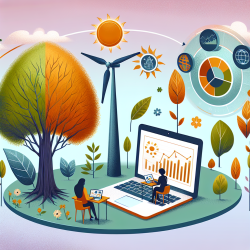Introduction
In the ever-evolving field of speech-language pathology, practitioners are continuously seeking innovative ways to enhance their practice and improve outcomes for children. A recent research article titled "Energy Sustainability with a Focus on Environmental Perspectives" provides insights that can be leveraged to advance the field of speech-language pathology. By understanding and applying the principles of energy sustainability, practitioners can make data-driven decisions that not only benefit their practice but also contribute to a more sustainable future.
Understanding Energy Sustainability
Energy sustainability is a multifaceted concept that involves using energy resources in a way that meets current needs without compromising the ability of future generations to meet theirs. The research highlights key components of energy sustainability, including low environmental and ecological impacts, sustainable energy resources, and high efficiencies. These components are crucial for ensuring that energy systems support sustainable development goals.
Applying Energy Sustainability in Speech-Language Pathology
While energy sustainability may seem distant from the practice of speech-language pathology, the underlying principles can be applied to enhance therapeutic outcomes. Here are some ways practitioners can integrate these concepts:
- Data-Driven Decisions: Just as energy sustainability relies on data to optimize resource use, speech-language pathologists can use data to tailor interventions to individual needs, ensuring efficient and effective therapy.
- Resource Optimization: By utilizing technology and online platforms like TinyEYE, practitioners can deliver therapy sessions more efficiently, reducing the need for physical resources and minimizing environmental impact.
- Holistic Approach: Consider the broader context of a child's environment, including social and ecological factors, to create more comprehensive and sustainable therapy plans.
Encouraging Further Research
The research on energy sustainability provides a foundation for further exploration into how these principles can be applied in speech-language pathology. Practitioners are encouraged to delve deeper into the study and consider how sustainable practices can be integrated into their work to improve outcomes for children.
Conclusion
By embracing the principles of energy sustainability, speech-language pathologists can enhance their practice and contribute to a more sustainable future. The integration of data-driven decisions, resource optimization, and a holistic approach can lead to better outcomes for children and a more environmentally conscious practice.
To read the original research paper, please follow this link: Energy Sustainability with a Focus on Environmental Perspectives.










